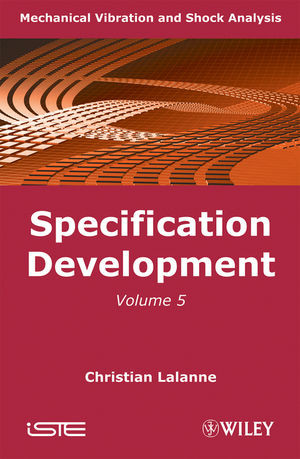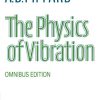Mechanical Vibration and Shock Analysis Specification Development Volume 5 2st Edition by Christian Lalanne ISBN 1848211260 9781848211261
$50.00 Original price was: $50.00.$35.00Current price is: $35.00.
Mechanical Vibration and Shock Analysis: Specification Development, Volume 5 2st Edition by Christian Lalanne – Ebook PDF Instant Download/Delivery: 1848211260, 978-1848211261
Full download Mechanical Vibration and Shock Analysis: Specification Development, Volume 5 2st Edition after payment
Product details:
ISBN 10: 1848211260
ISBN 13: 978-1848211261
Author: Christian Lalanne
Mechanical Vibration and Shock Analysis: Specification Development, Volume 5 2st Edition: Mechanical Vibration and Shock Analysis, Second Edition Volume 5: Specification Development This volume focuses on specification development in accordance with the principle of tailoring. Extreme response and the fatigue damage spectra are defined for each type of stress (sinusoidal vibration, swept sine, shock, random vibration, etc.). The process for establishing a specification from the life cycle profile of the equipment which will be subject to these types of stresses is then detailed. The analysis takes account of the uncertainty factor, designed to cover uncertainties related to the real–world environment and mechanical strength, and the test factor, which takes account of the number of tests performed to demonstrate the resistance of the equipment. The Mechanical Vibration and Shock Analysis five–volume series has been written with both the professional engineer and the academic in mind. Christian Lalanne explores every aspect of vibration and shock, two fundamental and extremely significant areas of mechanical engineering, from both a theoretical and practical point of view. The five volumes cover all the necessary issues in this area of mechanical engineering. The theoretical analyses are placed in the context of both the real world and the laboratory, which is essential for the development of specifications.
Mechanical Vibration and Shock Analysis: Specification Development, Volume 5 2st Edition Table of contents:
Chapter 1 Extreme Response Spectrum of a Sinusoidal Vibration 1
1.1 The effects of vibration 1
1.2 Extreme response spectrum of a sinusoidal vibration 2
1.3 Extreme response spectrum of a swept sine vibration 13
Chapter 2 Extreme Response Spectrum of a Random Vibration 21
2.1 Unspecified vibratory signal 22
2.2 Gaussian stationary random signal 23
2.3 Limit of the ERS at the high frequencies 49
2.4 Response spectrum with up-crossing risk 50
2.5 Comparison of the various formulae 62
2.6 Effects of peak truncation on the acceleration time history 66
2.7 Sinusoidalvibration superimposed on a broadband random vibration 68
2.8 Swept sine superimposed on a broadband random vibration 83
2.9 Swept narrowbands on a wideband random vibration 85
Chapter 3 Fatigue Damage Spectrum of a Sinusoidal Vibration 89
3.1 Fatigue damage spectrum definition 89
3.2 Fatigue damage spectrum of a single sinusoid 92
3.3 Fatigue damage spectum of a periodic signal 96
3.4 General expression for the damage 98
3.5 Fatigue damage with other assumptions on the S-N curve 98
3.6 Fatigue damage generated by a swept sine vibration on a single-degree-of-freedom linear system 102
3.7 Reduction of test time 121
3.8 Notes on the design assumptions of the ERS and FDS 124
Chapter 4 Fatigue Damage Spectrum of a Random Vibration 125
4.1 Fatigue damage spectrum from the signal as function of time 125
4.2 Fatigue damage spectrum derived from a power spectral density 127
4.3 Simplified hypothesis of Rayleigh’s law 132
4.4 Calculation of the fatigue damage spectrum with Dirlik’s probability density 138
4.5 Up-crossing risk fatigue damage spectrum 140
4.6 Reduction of test time 144
4.7 Truncation of the peaks of the “input” acceleration signal 149
4.8 Sinusoidal vibration superimposed on a broadband random vibration 152
4.9 Swept sine superimposed on a broadband random vibration 161
4.10 Swept narrowbands on a broadband random vibration 162
Chapter 5 Fatigue Damage Spectrum of a Shock 165
5.1 General relationship of fatigue damage 165
5.2 Use of shock response spectrum in the impulse zone 167
5.3 Damage created by simple shocks in static zone of the response spectrum 169
Chapter 6 Influence of Calculation Conditions of ERSs and FDSs 171
6.1 Variation of the ERS with amplitude and vibraiton duration 171
6.2 Variation of the FDS with amplitude and duration of vibration 175
6.3 Should ERSs and FDSs be drawn with a linear or logarithmic frequency step? 175
6.4 With how many points must ERSs and FDSs be calculated? 177
6.5 Difference between ERSs and FDSs calculated from a vibratory signal according to time and from its PSD 180
6.6 Influence of the number of PSD calculation points on ERS and FDS 187
6.7 Influence of the PSD statistical error on ERS and FDS 192
6.8 Influence of the sampling frequency during ERS and FDS calculation from a signal on time 193
6.9 Influence of the peak counting method 202
6.10 Influence of a non-zero mean stress on FDS 206
Chapter 7 Tests and Standards 217
7.1 Definitions 217
7.2 Types of tests 218
7.3 What can be expected from a test specification? 223
7.4 Specification types 224
7.5 Standards specifying test tailoring 235
Chapter 8 Uncertainty Factor 243
8.1 Need – definitions 243
8.2 Sources of uncertainty 247
8.3 Statistical aspect of the real environment and of material strength 249
8.4 Statistical uncertainty factor 272
Chapter 9 Aging Factor 293
9.1 Purpose of the aging factor 293
9.2 Aging functions used in reliability 293
9.3 Method for calculating the aging factor 296
9.4 Influence of the aging law’s standard deviation 299
9.5 Influence of the aging law mean 300
Chapter 10 Test Factor 301
10.1 Philosophy 301
10.2 Normal distributions 303
10.3 Log-normal distributions 315
10.4 Weibull distributions 318
10.5 Choice of confidence level 320
Chapter 11 Specification Development 321
11.1 Test tailoring 321
11.2 Step 1: analysis of the life-cycle profile. Review of the situations 322
11.3 Step 2: determination of the real environmental data associated with each situation 324
11.4 Step 3: determination of the environment to be simulated 325
11.5 Step 4: establishment of the test program 356
11.6 Applying this method ot the example of the “round robin” comparative study 363
11.7 Taking environment into account in project mamagement 366
Chapter 12 Influence of Calculation Conditions of Specification 375
12.1 Choice of the number of points in the specification (PSD) 375
12.2 Influence of the Q factor on specification (outside of time reduction) 378
12.3 Influence of the Q factor on specification when duration id reduced 382
12.4 Validity of a specification established for a Q factor equal to 10 when the real structure has another value 387
12.5 Advantage in the consideration of a variable Q factor for the calculation of ERSs and FDSs 388
12.6 Influence of the value of parameter b on the specification 390
12.7 Choice of the value of parameter b in the case of material made up of several components 394
12.8 Influence of temperature on parameter b and constant C 395
12.9 Importance of a factor of 10 between the specification FDS and the reference FDS (real environment) in a small frequency band 396
12.10 Validity of a specification established by reference to a one-degree-of-freedom system when real structures are multi-degree-of-freedom systems 398
Chapter 13 OPther Uses of Extreme Response, Up-Crossing Risk and Fitigue Damage Spectra 399
13.1 Comparisons of the severity of different vibrations 399
13.2 Swept sine excitation – random vibration transformation 403
13.3 Definition of a random vibration with the same severity as a series of shocks 408
13.4 Writing a specification only from an ERS (or an URS) 413
13.5 Establishment of a swept sine vibration specification 418
People also search for Mechanical Vibration and Shock Analysis: Specification Development, Volume 5 2st Edition:
mechanical vibration and shock analysis fatigue damage
mechanical vibration examples
mechanical vibration and shock measurements
vibration analysis examples
vibration analysis explained
Tags:
Christian Lalanne,Mechanical Vibration,Shock Analysis,Specification,Development,Volume 5



